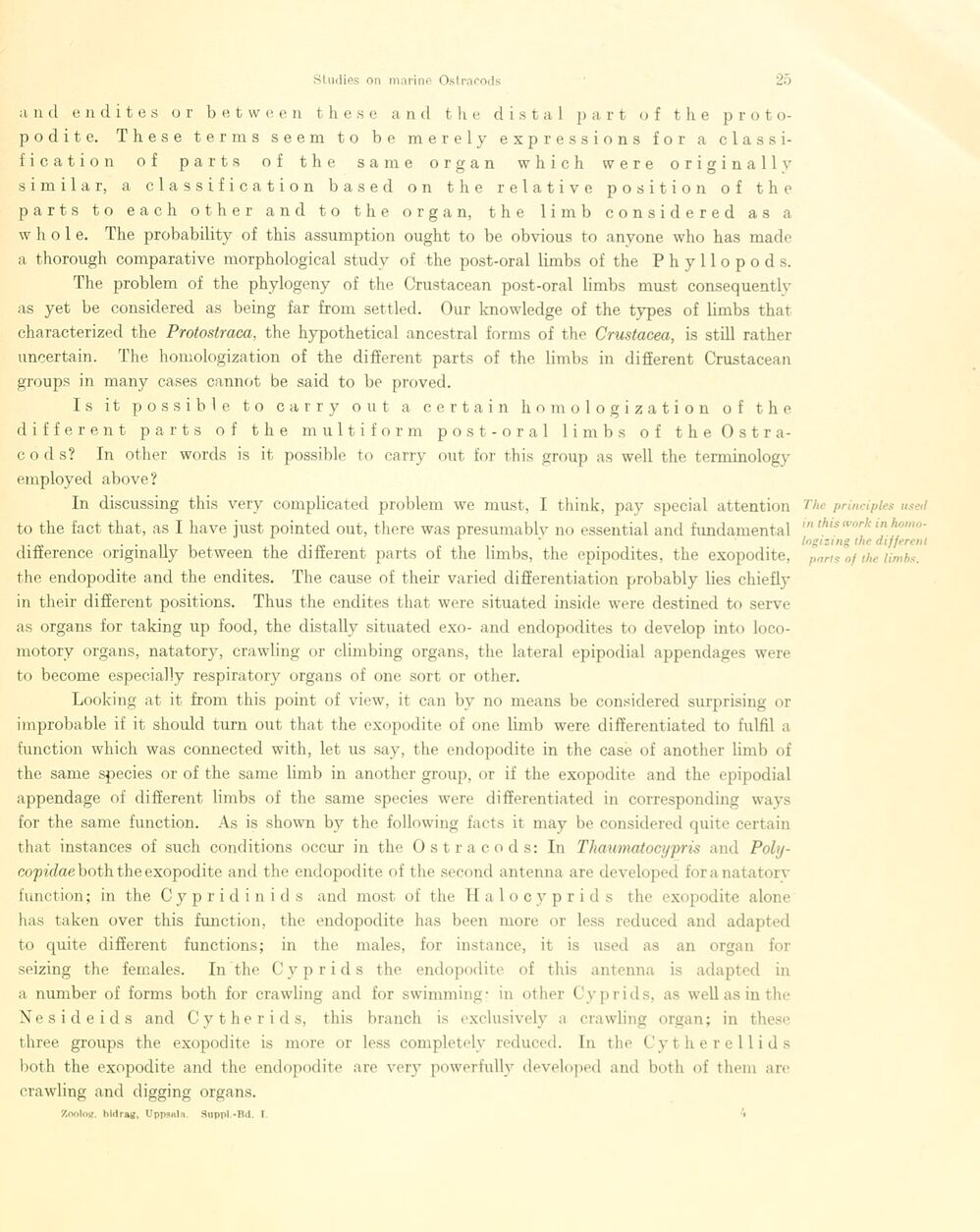
Full resolution (JPEG) - On this page / på denna sida - Sidor ...

<< prev. page << föreg. sida << >> nästa sida >> next page >>
Below is the raw OCR text
from the above scanned image.
Do you see an error? Proofread the page now!
Här nedan syns maskintolkade texten från faksimilbilden ovan.
Ser du något fel? Korrekturläs sidan nu!
This page has never been proofread. / Denna sida har aldrig korrekturlästs.
and e n d i t e s or b e t w e e n thèse and t h e distal part o f t h e p r o
topo d i t e. These terms seem to be merely expressions for a
classification of parts of the same organ w h i c h were originally
similar, a classification based on the relative position of the
parts to each other and to the organ, the limb considered as a
w h o 1 e. The probability of this assumption ought to be obvious to anvone who has made
a thorongh comparative morphological study of the post-oral limbs of the Phyllopods.
The problem of the phylogeny of the Crustacean post-oral limbs must consequenti v
as yet be considered as being far from settled. Our knowledge of the types of limbs that
characterized the Protostraca, the hypothetical ancestral forms of the Crustacea, is still rather
uncertain. The homologization of the different parts of the limbs in different Crustacean
groups in many cases cannot be said to be proved.
Is it possible to carry out a certain homologization of the
different parts of the multiform post-oral limbs of the
Ostracods? In other words is it possible to carry out for this group as well the terminology
employed above?
In discussing this very complicated problem we must, I think, pay special attention
to the faet that, as I have just pointed out, there was presumably no essential and fundamental
difference originally between the different parts of the limbs, the epipodites, the exopodite,
the endopodite and the endites. The cause of their varied differentiation probably lies chiefly
in their different positions. Thus the endites that were situated inside were destined to serve
as organs for taking up food, the distally situated exo- and endopodites to develop into
loco-motory organs, natatory, crawling or climbing organs, the lateral epipodial appendages were
to become especially respiratory organs of one sort or other.
Looking at it from this point of view, it can by no means be considered surprising or
improbable if it should turn out that the exopodite of one limb were differentiated to fulfil a
funetion which was connected with, let us say, the endopodite in the case of another limb of
the same species or of the same limb in another group, or if the exopodite and the epipodial
appendage of different limbs of the same species were differentiated in corresponding ways
for the same funetion. As is shown by the following facts it may be considered quite certain
that instances of such conditions occur in the Ostracods: In Thaumatocypris and
Poly-copidaehoth. the exopodite and the endopodite of the second antenna are developed for a natatory
funetion; in the Cypridinids and most of the Halocyprids the exopodite alone
has taken over this funetion, the endopodite has been more or less reduced and adapted
to quite different funetions; in the males, for instance, it is used as an organ for
seizing the females. In the Cyprids the endopodite of this antenna is adapted in
a number of forms both for crawling and for swimming- in other Cyprids, as well as in the
Nes ide ids and C y the rids, this branch is exelusively a crawling organ; in these
three groups the exopodite is more or less completely reduced. In the Cytherellids
both the exopodite and the endopodite are very powerfully developed and both of them are
crawling and digging organs.
Zoolo«, hidrag. Uppsuln. Suppl.-Bd. T ’
The principles used
in this tvork in
homologi sing the différent
parts of the limbs.
<< prev. page << föreg. sida << >> nästa sida >> next page >>